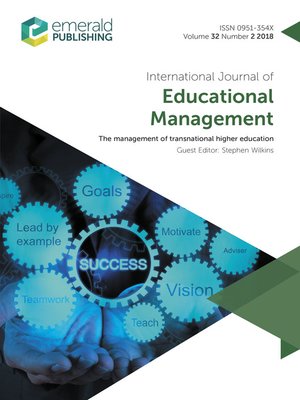International Journal of Educational Management, Volume 32, Number 2
ebook ∣ The management of transnational higher education · International Journal of Educational Management
By Stephen Wilkins

Sign up to save your library
With an OverDrive account, you can save your favorite libraries for at-a-glance information about availability. Find out more about OverDrive accounts.
Find this title in Libby, the library reading app by OverDrive.



Search for a digital library with this title
Title found at these libraries:
| Library Name | Distance |
|---|---|
| Loading... |
The management of transnational higher education can be a challenging and daunting task for institutional leaders, who typically have to deal with many new situations and work contexts, and often without having relevant previous experience or training. This special issue comprises eight articles. Each article focuses on a specific issue of management in transnational higher education. Collectively, the articles are concerned with diverse topics and ideas, which may help institutional decision-makers and managers to improve employee and institutional performance, as well as the student experience.The first paper in this special issue, proposes the use of an adapted Porter Diamond Model. Applying the model to China and Malaysia, it is confirmed that these two countries are attractive for the development of new transnational ventures, or expanding existing ones. The author claims that the model can be further used by institutions to evaluate other possible host countries in order to develop strategies that increase the attractiveness of the country. The second article adopts a student perspective to evaluate the importance of institutional reputation, student trust, and student-university identification in international partnerships. The authors conclude that when evaluating potential partners, decision-makers should consider the potential partner's reputation and the extent to which students trust and identify with it. The third article examines the challenges of managing transnational education partnerships. The findings suggest that universities need to do more to increase awareness and commitment to their partnerships among staff at home campuses, while providing improved professional development and more frequent rotations for in-country managers. The fourth article, investigates how the branding practices of franchisees in the UAE employ discursive and symbolic strategies to build legitimacy. The findings suggest that in order to satisfy the expectations of their diverse stakeholders, franchisees need to go beyond symbolic assurances in their legitimacy-building and commit resources to making substantive changes to the institution's goals, structures and processes. The fifth article examines how cross-country cultural differences influence the design and management of two franchise and one joint degree programme in Chinese-British/French partnerships. The authors argue that the needs and requirements of both parties should be considered when making decisions about the design and management of transnational programmes, which typically requires a degree of compromise from each side. The sixth article investigates the attitudes of male postgraduate students to assisted or arranged marriages and the impacts of matrimonial practices on participation in transnational higher education. The authors call on managers in transnational education to show greater cultural sensitivity with regard to the ritual formalities – in this case, associated with marriage – that need to be observed by students in their own cultures, which may, at times, result in absenteeism from classes or examinations. The seventh article examines student perceptions and experiences of student engagement. In this study, student engagement is defined as the process of interaction between students, staff and the institution for the benefit of quality improvement. The authors recommend that institutions involved with transnational learners focus more on engagement and implement strategies that tackle the apathy which currently exists among both students and staff. The eight paper, a concluded article presents a critical evaluation of the evolution of one international branch campus over an eight-year...







